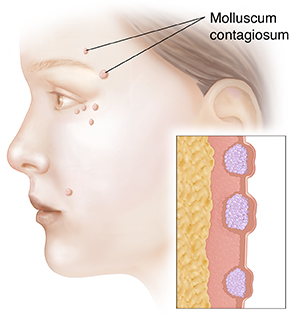A
B
C
D
E
F
G
H
I
J
K
L
M
N
O
P
Q
R
S
T
U
V
W
X
Y
Z
Topic IndexLibrary Index
Click a letter to see a list of conditions beginning with that letter.
Click 'Topic Index' to return to the index for the current topic.
Click 'Library Index' to return to the listing of all topics.
Understanding Molluscum Contagiosum
Molluscum contagiosum is a skin infection. It causes small bumps on the body. The bumps can range in size from as small as a pinhead to as large as a pencil eraser. Children and young adults are most often affected. It’s also more likely to occur in people who have a weak immune system, such as from HIV.

How to say it
mohl-UHS-kuhm kuhn-tay-jee-OH-suhm
What causes molluscum contagiosum?
Molluscum contagiosum is caused by a virus. The virus may first enter your body through a break in the skin, such as a cut. It can then spread to other parts of your body by touching, shaving, or scratching a bump. It can also spread from person to person by touch. Or it may be spread by sharing personal items, such as towels and razors.
Symptoms of molluscum contagiosum
Molluscum contagiosum causes small, dome-shaped bumps on the body. They often appear on the face, arms, legs, and trunk. In sexually active adults, the bumps may be found on the genitals or the skin around the groin area. These bumps are shiny and white or skin-colored. They also have a small dimple in the middle of them. They may sometimes get sore and swollen and cause redness and itching.
Treatment for molluscum contagiosum
If the bumps are not causing any problems, you may not need treatment. They may go away on their own in a few months or years. But they can also spread. You may need treatment if the infection is widespread or if you have a weak immune system. Treatment choices include:
-
Cryotherapy. Putting liquid nitrogen on the bumps may freeze them off. A blister forms and the bump peels off.
-
Physical removal. Your healthcare provider can use a few methods to scrape off or remove the bumps. This can sometimes be painful and might cause scarring.
-
Medicine. Different gels, chemicals, or solutions may help clear the skin.
When to call your healthcare provider
Call your healthcare provider right away if any of the following occur:
-
Fever of 100.4°F ( 38°C) or higher, or as directed by your healthcare provider
-
Pain that gets worse
-
Symptoms that don’t get better, or get worse
-
New symptoms
Online Medical Reviewer:
Barry Zingman MD
Online Medical Reviewer:
L Renee Watson MSN RN
Online Medical Reviewer:
Marianne Fraser MSN RN
Date Last Reviewed:
5/1/2022
© 2000-2024 The StayWell Company, LLC. All rights reserved. This information is not intended as a substitute for professional medical care. Always follow your healthcare professional's instructions.